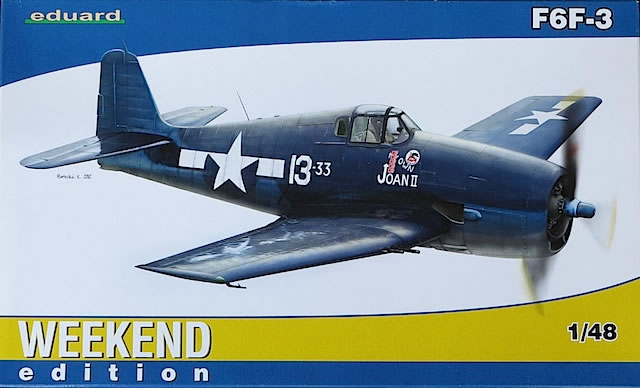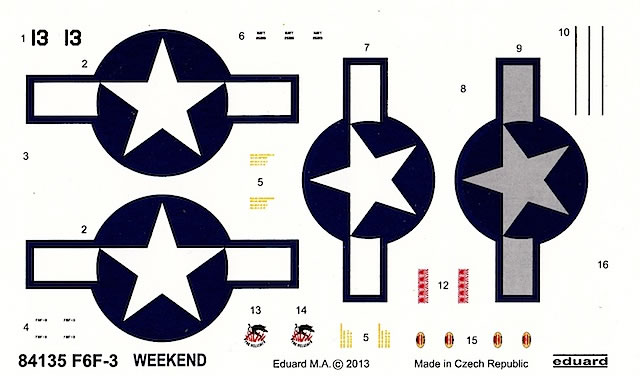|
F6F-3
Weekend Edition

Eduard, 1/48 scale
S u m m a r y : |
Catalogue Number: |
Eduard Kit No.84135 – F6F-3 Weekend Edition |
Scale: |
1/48 |
Contents & Media: |
Approximately 101 olive and grey plastic parts (21 unused); 17 clear plastic parts (1 unused); 1 decal sheet containing markings for 1 aircraft; 8 page black and white instruction booklet. |
Price: |
USD$21.21 plus shipping available online from Eduard’s website |
Review Type: |
First Look |
Advantages: |
Excellent and versatile base kit; interesting marking option for an early, land-based F6F-3 |
Disadvantages: |
|
Conclusions: |
Another enticing Weekend Edition Hellcat – highly recommended! |
Reviewed by
Brad Fallen

Eduard's 1/48 scale F6F-3 Weekend Edition is available online from Squadron.com
The initial Hellcat production version, the F6F-3 first flew in October 1942 and entered combat in August 1943. By the time Grumman switched to F6F-5 manufacturing in April 1944, just over 4,402 F6F-3s had been built out of an eventual total Hellcat production of 12,200.
With so many examples completed, it is not surprising that Grumman introduced a number of modifications during the F6F-3 production run. According to Bert Kinzey in ‘F6F Hellcat in Detail and Scale’, the main externally identifiable changes were:
-
Removal of the port underwing landing light from the 272nd aircraft onwards;
-
Removal of the .50 caliber machine gun fairings from approximately the 900th aircraft onwards;
-
Alteration of the angle of the radio mast, from forward-leaning to perpendicular, from the 910th aircraft onwards;
-
Deletion of the lower cowl flaps from the 1265th aircraft onwards; and
-
Relocating the radio mast from slightly left of centreline to slightly right of centreline from the 2561st aircraft onwards.
The bulged exhaust fairings were also deleted from approximately the 1,500th aircraft onwards. These features, cross-referenced against individual Hellcat bureau numbers, are invaluable in helping to identify and accurately model specific F6F-3s. However they shouldn’t be used as a hard-and-fast guide because there were always exceptions to the rule; this is where reference photos are essential.
Eduard first released its 1/48 F6F-3 kit in Weekend Edition format back in 2009, with decals for a VF-1 aircraft flown by Lt. William Moseley off USS Yorktown in mid-1944. Now Eduard has released a second F6F-3 Weekend Edition, this time with different markings – although like the initial boxing, these have been drawn from the F6F-3 Profipack kit first issued in 2008.
As I noted in my review of the F6F-5 Early Profipack kit in May this year, Eduard’s 1/48 Hellcat family now runs to at least ten different boxings and nine different variants. This range has been made possible by Eduard’s moulding of two different fuselage sprues, two different wing sprues, and four different cowling sprues, which are then married up as required.
For the latest F6F-3 Weekend Edition, Eduard has matched early fuselage halves and cowlings (sprue C) with early wings (sprue A) and generic Hellcat sprues E and G to deliver a very early F6F-3. A number of parts are not required and thus destined for the spares box, including the bombs, bomb racks, mid-series cowlings (with the bulged exhaust fairings and no single flaps), and late series windscreen.
All of the parts are moulded to Eduard’s usual high standard, with small attachment gates, well defined surface detail and smooth plastic that will require little attention before painting. There is no flash or obvious mould wear, which means that detail in the cockpit and elsewhere is not particularly compromised by the absence of photo-etched parts. I would however recommend adding a seat harness, as well as instrument panel dials that on this occasion are not included as an option on the decal sheet.
The clear parts are also very good, and given their limited amount of framing should be relatively straightforward to mask.

Markings
The sole Weekend Edition marking option is an interesting one, for ‘My Own Joan II’/BuNo.25813, flown by five-victory ace Lt. C. ‘Ken’ Hildebrandt of VF-33 based in New Georgia, Solomon Islands between August and December 1943. The aircraft was finished in the then standard tricolour scheme of Sea Blue, Intermediate Blue and White, and is depicted by Eduard at the end of Hildebrandt’s tour when it carried five victory markings. By this stage, after four months of flying off rough airstrips in the inhospitable Solomons climate, ‘My Own Joan II’ was well and truly weather beaten; a photo in Osprey’s ‘Hellcat Aces of World War 2’ reveals a paint finish that was very faded, chipped and stained. If you like weathering, you’ll love this marking choice; if you don’t, there are plenty of other 1/48 Hellcat decals available.

As BuNo.25813, ‘My Own Joan II’ was amongst the first thousand or so F6F-3s completed. It almost certainly had bulged exhaust fairings and a full suite of cowl flaps. The aircraft was manufactured after the port underwing landing light was deleted, and close to when the gun fairings were removed and the angle of the radio mast changed from forward-leaning to perpendicular. However, the radio mast on ‘My Own Joan II’ was replaced with a mid-spine whip aerial, as fitted to most VF-33 Hellcats at this time (and illustrated by Eduard in its marking guide). Unfortunately I haven’t been able to find a photograph of ‘My Own Joan II’ in its entirety, so I don’t know if Eduard’s interpretation of fairing-less guns is correct; pictures of other VF-33 Hellcats in the Solomons at this time suggest it might be.
The decals have been produced by Eduard and look good. There are no registration issues and printing is crisp, down to the Japanese flag victory markings and VF-33 ‘The Hellcats’ unit insignia. The US national insignia appear to be accurate, although I am not an expert and am happy to stand corrected. Eduard has depicted the insignia on the upper port wing as overpainted in a slightly darker colour, which was presumably done to reduce the contrast between white and blue. This interpretation appears to be supported by photos I have found of other VF-33 Hellcats on New Georgia.
As is now the norm with Weekend Edition kits, no stencils are provided.
This is another enticing Weekend Edition release from Eduard that combines its excellent Hellcat plastic with an interesting, early F6F-3 marking option. Highly recommended for anyone who wants an eye-catching Hellcat model that won’t break the bank.
References
Bert Kinzey, ‘F6F Hellcat in Detail and Scale’ (Squadron/Signal Publications, 1996).
Barrett Tillman, ‘Hellcat Aces of World War 2’ (Osprey, 1996).
Thanks to Eduard for the sample and for the images.
Review Text Copyright © 2013 by Brad Fallen
Page Created 8 July, 2013
Last updated
8 July, 2013
Back to HyperScale Main Page
Back to Reviews Page

|
